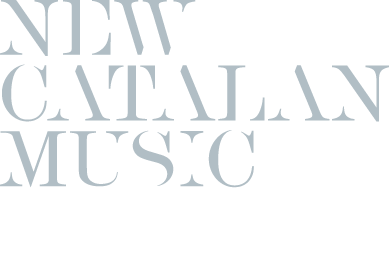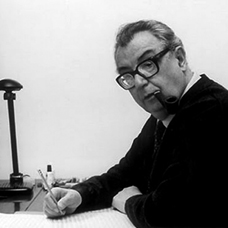Joan Guinjoan
Contemporary music
(Joan Guinjoan, Riudoms 1931)
Composer, pianist and conductor, he is one the most important figures in Spain from the second half of the 20th century.
Born in the Tarragona region of Baix Camp, in a family of farmers whose footsteps he was supposed to follow, he began in the world of music at fourteen, studying piano at the Conservatori del Liceu in 1952. Two years later, he moved to Paris to complete his training at the École Normale de Musique, which received his debut as a pianist in the French capital with a recital at the Salle Cortot on April 23, 1955.
The fifties was a decade of endless concerts, with tours and recitals throughout Spain, France and Germany. This is a period that would stop a decade later, after having given more than two hundred and fifty shows. He stopped so as to dedicate himself solely to composing, which he studied with the Catalan Cristòfor Taltabull, and later on his return to Paris at the Schola Cantorum, where he worked with Pierre Wissmer (composition), Edmund Pendleton (orchestra conducting) and Jean-Étienne Marie (electro acoustic). In this Parisian environment, he picked up on avant-garde techniques. He attended Olivier Messiaen’s classes and the astonishing concerts of the Domaine Musical de Pierre Boulez. In 1964, he took a new turn as a conductor by creating the Barcelona group Diabolus in Musica, meaning a way to premiere new scores and spread the work of the 20th century classics in the country’s main festival. With this group, he released the first recording in Spain of Igor Stravinsky’s The Soldier’s Tale.
His beginnings as a composer are marked by a serious interest in the possibilities of timbral analysis. His first official premiere was Suite op. 1, núm. 1 (1960), performed by Guinjoan himself in his final recital as a pianist on April 25, 1960, at the Teatro Pérez Galdós de Las Palmas de Gran Canaria. This was a hit that led to such interesting works such as Células (for piano), the ballet Los cinco continentes (premiered at the Gran Teatre del Liceu in 1969), the symphonic poem for choir and orchestra La rosa dels vents (winner of the Ciutat de Barcelona prize in 1978), and a piece of irresistible timbral magnetism, Ab Origine (1974). Works like Tensió-Relax (1972), El Diari (1977) and Acta Fabula (1975) for voice and instrumental group, show a period of transition, of search for a freer language, being the result of his command in the most diverse techniques and aesthetics, from dodecaphonism and serialism all the way to graphism and more flexibility in his music.
The stunning Música per a violoncel i orquestra (from 1975 but revised in 1980) marks a new path taken, with greater expressiveness, clarity and formal perfection that plays with the idea of “instrumental humanization” in face of cold experimentation. The varied percussion, the rich orchestral palette, the rhythmic vitality and timbral richness turn into signs of a musical identity that gets more and more warm, subtle and imaginative. His concerts for piano, for violin and for guitar, his chamber pieces Trio per archi (1982), the impactful Hommage à Carmen Amaya that Percussions de Strasbourg premiered in Tolosa de Llenguadoc, and one of his most important creations, Passim Trio (1988) all demonstrate Guinjoan’s brilliant new style, which reaches its climax with its excellent Concert per a piano (1983). This last piece was later dedicated to the memory of the socialist ex minister murdered by ETA, Ernest Lluch.
An equally outstanding piece is Gaudí, his first and only opera, with libretto by Josep Maria Carandell, which was commissioned in 1989 by the Olimpiada Cultural, as part of an ambitious program of activities for the Barcelona Olympic Games in 1992. Finally in 2004, after such a long wait, it was premiered at the Liceu with Josep Pons conducting. With a remarkable score, his ballet Trencadís was also a hit, consisting of two acts and a masterpiece of opulent orchestral virtuosity, rewritten in 1994. In 2007, there were several pieces premiered at the Festival de Santander by the Brodsky Quartet: the quartet with piano Self-Paráfrasis (1997); the exceptional Concert per a clarinet (2004), commissioned by the Orquestra Simfònica de Barcelona i Nacional de Catalunya (OBC) and dedicated to Joan Enric Lluna; the intense Simfonia n. 2, «Ciutat de Tarragona» (1999), in which the composer uses thematic motifs that resound with his birthplace, and his Quartet de corda núm. 1. All of these pieces were presented in Barcelona a year later by the Arditti Quartet, showing with great eloquence the growth of a classic of contemporary creation.
In 2003, as a result of a commission from the Rèsidencia d’Investigadors del Consell Superior d’Investigacions Científiques de Barcelona (CSIC), the pianist Josep Colom premiered Verbum (Genoma in música). This is a work inspired by the discovery of a gene associated to speaking, with which he gives birth to a new line of scores of a scientific nature, which reappears in his Tercera Simfonia, «Sincrotró Alba», commissioned by the same institution to celebrate the inauguration of a great accelerator of particles in Cerdanyola del Vallès (Barcelona). Born from a creative impulse charged with energy and written with an admirable command of technical and expressive methods, this Tercera Simfonia must be considered one of the most fundamental in all contemporary Catalan music. Its premiere took place on May 7, 2010 at the Auditori de Barcelona, performed by the OBC and conducted by Ernest Martínez Izquierdo, one of the best performers of Guinjoan’s music, who has also recorded the work under the label Tritó, alongside the Simfonia núm. 2, «Ciutat de Tarragona».
The composer’s first piece written for the cobla, Arrels (2008), premiered at the Palau de la Música Catalana for the Cobla Sant Jordi-Ciutat de Barcelona with Josep Pons conducting; the piece Sons de la terra (2007), written as requested by the prestigious accordionist Iñaki Alberdi or the Tres seqüències per a clarinet baix (2010), premiered by Harry Sparnay in Barcelona, show the composer’s flexibility and imagination, always willing to explore the qualities of the most diverse instruments.
The celebration of his 80th birthday generated a notable series of acts and homage concerts in the main Spanish auditoriums. Likewise, the Carta Blanca program is an annual series of concerts and activities set on discovering the music of an international composer. In March 2012, the Carta Blanca was fully dedicated to him, during which he performed again Tercera Simfonia, then followed by a large commemorative exhibit of his life and career opened. Within the same context, the Orquestra de Cadaqués, conducted by Jaime Martín, premiered on January 15, 2013, at the Palau de la Música Catalana, his Concert de percussion, commissioned by the same ensemble and the Fundación Autor, virtuousistic work performed by the percussionist Miquel Bernat.
It is also worthy highlighting a new very ambitious artistic endeavour that he has undertaken, with the support of the record label Columna Música: the release of his symphony and piano (with pianist José Menor) recordings, among others, from which three first volumes have already been released. Another notable feat is the DVD release of his opera Gaudí, a live recording of the premiere at the Gran Teatre del Liceu, with staging done by Manuel Huerga and production by Xavi Bové.
Apart from his artistic activity, he has also developed himself on an important pedagogic task for spreading music, working as a music critic and creating the Festival de Música Contemporània de Barcelona. He wrote the book Ab Origine (Àmbit Serveis Editorials SA. Barcelona, 1981) where he sums up his thoughts on music. He has won countless number of awards and prizes. He is the Officier dans l’Ordre des Arts et des Lettres, and Doctor Honoris Causa by the Universitat Rovira i Virgili de Tarragona. He won the prize Nacional de Música del Ministerio de Cultura (1990) and from the Generalitat de Catalunya (1995) and the Ajuntament de Barcelona awarded him with a Gold medal for artistic merit (1998). In 2004, he received the 5th Premio Iberoamericano de la Música Tomás Luis de Victoria. And finally, the Palau de la Música Catalana selected him as a resident composer for the 2012-2013 concert season.




 twitter
twitter flickr
flickr facebook
facebook RSS
RSS spotify
spotify youtube
youtube
